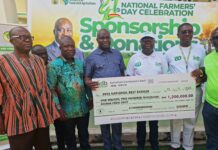While world’s biggest chocolate companies see their profits soar, they fail to keep their promises to improve the wages of the farmers who grow cocoa in Ghana, one of the main producing countries in the world, NGO Oxfam has denounced in a report.
In a report published recently, Oxfam said earnings for US companies Hershey, Mars, and Mondelez in addition to Italy’s Ferrero and Swiss peers Lindt & Spruengli and Nestle had increased since the onset of the pandemic in 2020, a period when inflation had skyrocketed.
The world’s four largest public chocolate corporations, (Hershey, Lindt, Mondelēz, and Nestlé] together made nearly $15 billion in profits from their confectionary divisions alone since the pandemic broke. This amount was up by an average of 16 percent since 2020.
The giants paid out on average more than their total net profits (113 percent) to shareholders between 2020 and 2022.
At the same time, an Oxfam survey of more than 400 cocoa farmers in Ghana — the second-largest global producer of the commodity — found their net incomes had fallen by an average of 16 percent since the same period with women cocoa farmers’ income dropped by an average of 22 percent, it added.
“There’s big money in chocolate — but definitely not for farmers,” said Oxfam International’s interim executive director, Amitabh Behar worded plainly.
“Cocoa farmers work extremely hard, under grueling conditions, yet can’t always feed their families.”
The charity claimed that up to 90 percent of Ghanaian cocoa farmers do not earn a living income, “meaning they cannot afford enough food or other basics such as clothing, housing, and medical care. Adding that “many of the 800,000 farmers in the country survive on just $2 a day.”
The NGO also noted that while Ghana produces about 15% of the world’s beans, it receives only about 1.5% of the sector’s estimated $130 billion annual global earnings.
Giant Nestlé said that while it “cannot influence the farm-gate prices due to the cocoa-trade structure in Ghana” the company does “everything to help cocoa-farming families close the living income gap”.
It told AFP that it strives also to help improve incomes for farmers in Ivory Coast, the world’s biggest producer of cocoa.
Ivory Coast and Ghana, both located in West Africa, together produce about two-thirds of the world’s cocoa.
Ferrero said farmers in the countries receive a cash premium on top of the commercial price for cocoa and have been among the first companies to fully support the Living Income Differential (LID),” it said in a statement.








